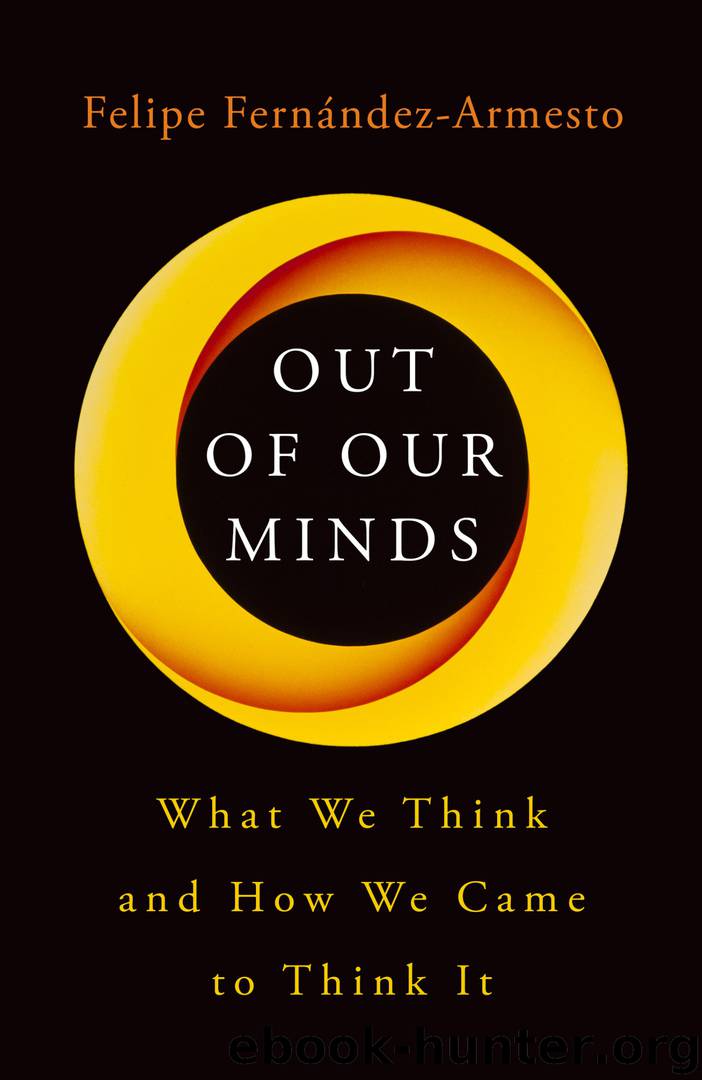Out of Our Minds by FERNANDEZ-ARMESTO FELIPE.;

Author:FERNANDEZ-ARMESTO, FELIPE.;
Language: eng
Format: epub, mobi
Tags: History;Human history;Human development;Imagination;Ideas;Sapiens;Civilization;Science;Politics;Philosophy;Culture;Art;1492
Publisher: Lightning Source Inc. (Tier 2)
Published: 2019-04-24T17:33:55+00:00
Redefining Humanity
In the sixteenth century, a further consequence of the construction of extra-European empires was to turn political thought back to wider considerations that transcended the limits of states. ‘All the peoples of humankind are human’, said the Spanish moral reformer Bartolomé de Las Casas in the mid-sixteenth century.56 It sounds like a truism, but it was an attempt to express one of the most novel and powerful ideas of modern times: the unity of humankind. The recognition that everyone we now call human belonged to a single species was by no means a foregone conclusion. To insist, as Las Casas did, that we all belong to a single moral community was visionary.
For in most cultures, in most periods, no such concept existed. Legendary monsters, often mistaken for products of teeming imaginations, are really the opposite: evidence of people’s mental limitations – their inability to conceive of strangers in the same terms as themselves. Most languages have no term for ‘human’ that comprehends those outside the group: most peoples refer to outsiders by their name for ‘beasts’ or ‘demons’.57 There is, as it were, no middle term between ‘brother’ and ‘other’. Although sages of the first millennium bce had expatiated on the unity of humankind, and Christianity had made belief in our common descent a religious orthodoxy, no one was ever sure where to draw the line between humans and supposed subspecies. Medieval biology imagined a ‘chain of being’ in which, between humans and brute beasts, lay an intermediate, monstrous category of similitudines hominis – creatures resembling men but not fully human. Some of them appeared vividly to the imaginations of mapmakers and illuminators, because the Roman naturalist Pliny catalogued them, in a work of the mid-first century ce, which Renaissance readers treated with all the credulity an ancient text was thought to deserve. He listed dog-headed men, and Nasamones, who wrapped themselves in their enormous ears, Sciapods who bounced around on one leg, pygmies and giants, people with backward-turned, eight-toed feet, and others who took nourishment by inhaling for want of mouths, or had tails or lacked eyes, sea-green men who battled griffins, hairy folk, and Amazons, as well as ‘the Anthropophagi and men whose heads do grow beneath their shoulders’ who were among the adversaries Shakespeare’s Othello faced.
Medieval artists made the images of these creatures familiar. Should they be classed as beasts or men or something in between? On the portico of the twelfth-century monastery church of Vézelay many of them appear in procession, approaching Christ to be judged at the Last Trump; so the monks clearly thought the weird creatures capable of salvation, but other scrutineers, with the authority of St Albertus Magnus, denied that such aberrations could possess rational souls or qualify for eternal bliss. Naturally, explorers were always on the lookout for such creatures. It took a papal bull to convince some people that Native Americans were truly human (even then some Protestants denied it, suggesting that there must have been a second creation of a different species or a demonic engendering of deceptively human-like creatures in America).
Download
Out of Our Minds by FERNANDEZ-ARMESTO FELIPE.;.mobi
This site does not store any files on its server. We only index and link to content provided by other sites. Please contact the content providers to delete copyright contents if any and email us, we'll remove relevant links or contents immediately.
Sapiens: A Brief History of Humankind by Yuval Noah Harari(14171)
Sapiens by Yuval Noah Harari(5269)
Pale Blue Dot by Carl Sagan(4867)
Homo Deus: A Brief History of Tomorrow by Yuval Noah Harari(4781)
Livewired by David Eagleman(3626)
Origin Story: A Big History of Everything by David Christian(3594)
Brief Answers to the Big Questions by Stephen Hawking(3321)
Inferior by Angela Saini(3213)
Origin Story by David Christian(3121)
The Gene: An Intimate History by Siddhartha Mukherjee(3014)
Signature in the Cell: DNA and the Evidence for Intelligent Design by Stephen C. Meyer(3002)
The Evolution of Beauty by Richard O. Prum(2918)
Aliens by Jim Al-Khalili(2767)
How The Mind Works by Steven Pinker(2701)
A Short History of Nearly Everything by Bryson Bill(2585)
Sex at Dawn: The Prehistoric Origins of Modern Sexuality by Ryan Christopher(2444)
From Bacteria to Bach and Back by Daniel C. Dennett(2426)
Endless Forms Most Beautiful by Sean B. Carroll(2406)
Who We Are and How We Got Here by David Reich(2377)
